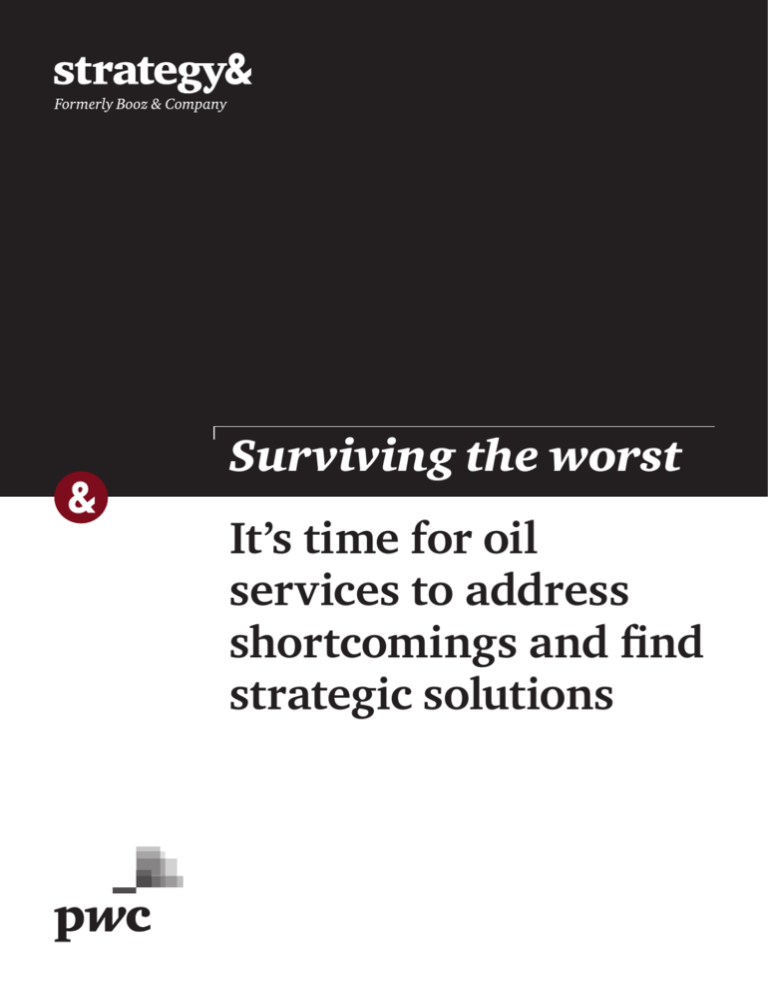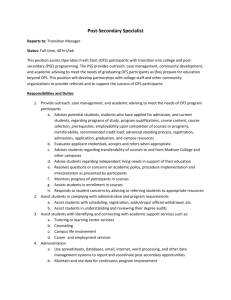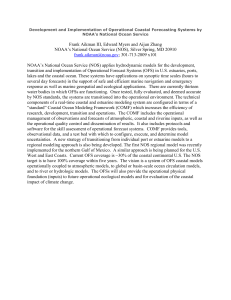
Surviving the worst
It’s time for oil
services to address
shortcomings and find
strategic solutions
Contacts
About the authors
Amsterdam
Dubai
Melbourne
Douwe Tideman
Partner
+33-1-44-34-3127
douwe.tideman
@strategyand.pwc.com
David Branson
Executive Advisor
+971-4-390-0260
david.branson
@strategyand.pwc.com
Malcolm Garrow
Partner
+61-3-9221-1928
malcolm.garrow
@strategyand.pwc.com
Beirut
Houston
Milan
Georges Chehade
Partner
+961-1-985-655
georges.chehade
@strategyand.pwc.com
Juan Trebino
Partner
+1-713-650-4151
juan.trebino
@strategyand.pwc.com
Giorgio Biscardini
Partner
+39-02-72-50-92-05
giorgio.biscardini
@strategyand.pwc.com
Dallas
London
São Paulo
John Corrigan
Partner
+1-214-746-6558
john.corrigan
@strategyand.pwc.com
Viren Doshi
Senior Partner
+44-20-7393-3572
viren.doshi
@strategyand.pwc.com
Arthur Ramos
Partner
+55-11-5501-6229
arthur.ramos
@strategyand.pwc.com
Shawn Maxson
Partner
+1-214-712-6691
shawn.maxson
@strategyand.pwc.com
Andrew Clark
Partner
+44-20-7393-3418
a.clark
@strategyand.pwc.com
Adrian del Maestro
Director
+44-20-7393-3558
adrian.delmaestro
@strategyand.pwc.com
Viren Doshi is a senior
partner with Strategy&
based in London, in the
oil and gas practice.
He has more than
30 years of energy
industry experience,
and specializes in
implementing pioneering
strategic transformations
and mergers, managing
supply and trading in
volatile markets, and
designing innovative
business models.
John Corrigan is a
partner with Strategy&
based in Dallas, aligned
to the firm’s energy,
chemicals, and utilities
practice. His main focus is
on natural gas midstream
and energy markets,
and he has worked with
public and governmentowned utilities in the
U.S. and Canada.
Shawn Maxson is a
partner with Strategy&
based in Dallas, working
with the energy,
chemicals, and utilities
and operations practices.
He is a 20-year veteran of
the upstream oil and gas
industry, where he is a
widely recognized expert
across all supply chain
management domains.
Adrian del Maestro is a
director with Strategy&
based in London. He
leads the firm’s global
research capabilities in
the oil and gas practice.
Strategy& principal Ahmad Filsoof and associate Jahanzeb Sheikh also contributed to this report.
2
Strategy&
Executive summary
It seemed as if nothing could go wrong for oil-field services (OFS)
companies — until recently. With oil and gas reserves expanding, and
oil and gas producers increasing their capital investments annually,
the innovation and technological expertise of the OFS sector were in
high demand. However, the dramatic collapse of oil prices and the
need for oil and gas producers to sharply curtail their capital budgets
have laid bare fundamental shortcomings and weaknesses in the OFS
sector that were papered over by the industry boom. Throughout the
growth period, OFS companies have actually suffered declining profit
margins as up-front development and project costs soared; prices of
raw materials vacillated; poorly chosen acquisitions failed to meet
growth, synergy, and integration targets; and complexity, with its
attendant costs to business and organizational models, increased in
tandem with demand.
To survive this growing financial turmoil, OFS companies will need to
creatively pull a number of strategic levers that include more innovative
risk-sharing contracts, restructuring internal costs, integrating complex
service offerings, and a more coherent framework for reviewing their
asset portfolio with the goal of divesting noncore businesses.
Strategy&
3
The good, the bad
Until the past few months, the global oil-field services (OFS) sector
was basking in rarefied air. Although these companies do not get the
headlines or even the stock market attention of the oil and gas
producers they serve, they have been the backbone of the recent rapid
expansion in resource exploration — and they have enjoyed the fruits
of outsized capital spending campaigns that increased year over year.
As the firms that provide the equipment and technological know-how
for hydrocarbon exploration and production — ranging from 4-D
seismic services to horizontal drilling — OFS businesses played an
indispensable role in helping international oil companies (IOCs) and
national oil companies (NOCs) enhance oil and gas production yield
during a boom that saw global oil reserves increase 27 percent to 1.7
trillion barrels between 2003 and 2013 and natural gas reserves
grow 19 percent to 186 trillion cubic meters during that time.
In this flourishing marketplace, OFS companies generated impressive
financial results. Industry sales have grown at a compound annual
rate of 11 percent since 2005, to reach US$440 billion last year (see
Exhibit 1, next page).
That’s perhaps not as surprising as the fact that the largest OFS companies
handily outperformed their oil and gas company counterparts in revenue,
EBITDA, market capitalization, and stock price CAGR gains since 2006
(see Exhibit 2, page 6, and Exhibit 3, page 7).
A primary
reason that
oilfield services
companies
have been so
successful is
their record of
innovation.
A primary reason that oil-field services companies have been so
successful is their record of innovation. As the shale and unconventional
resource revolution widened, OFS firms continued to push the envelope
with breakthroughs like multistage fracking, which gives a shale project
access to multiple wells and resource beds; steerable rotary bits that
reduce drilling time by some 50 percent; and pad drilling, which lets
companies target a wide swath of underground reserves from a
proscribed region on the surface. Their ability to innovate made
OFS companies attractive partners for hydrocarbon producers,
especially NOCs, which pay them fees for their services but don’t have
to give them equity stakes in the reserves the way IOCs sometimes do.
4
Strategy&
Exhibit 1
Global oil-field services market by sales
US$ in millions
450,000
400,000
+11%
350,000
300,000
250,000
200,000
150,000
100,000
50,000
0
2005
2006
2007
2008
2009
2010
2011
2012
2013
2014
Source: Spears &
Associates Oilfield Market
Report, 2005–14
Strategy&
5
Exhibit 2
Oil supermajors vs. leading OFS players
CAGR for selected metrics, Q3 2006–Q3 2014
% growth
14
12
10
8
6
4
2
Supermajors
OFS
0
-2
Revenue
EBITDA
Market capitalization
Note: Supermajors are
BP, Shell, Total, Chevron,
and Exxon. OFS leading
players are Schlumberger,
Halliburton, and Baker
Hughes.
Source: Bloomberg;
Strategy& research
6
Strategy&
Exhibit 3
World oil services index vs. world oil & gas index, rebased 2006–15
Index
200
180
160
-33%
140
120
-23%
100
80
60
40
2006
2007
2008
2009
2010
2011
2012
2013
2014
2015
2016
Bloomberg World OFS Index
Bloomberg World O&G Index
Source: Bloomberg;
Strategy& research
Strategy&
7
Moreover, the oil-field services sector typically invests more in R&D
than IOCs do. In 2013, the largest OFS companies earmarked an
average of 0.7 percent of sales for R&D, compared
with an average of 0.4 percent for the supermajors, according to
Strategy&’s analysis.
With money flowing freely in its direction, the OFS sector has become
heavily fragmented. The top five companies by market share — namely,
Schlumberger, Halliburton, Baker Hughes, National Oilwell Varco,
and Weatherford, according to the latest stock exchange data — stand
out by the depth of their scaled operations and the width of their
footprints. Together, they control about one-third of oil-field services
business. That leaves a myriad of smaller players with a combined
majority share, hoping to stake a claim to some slice of the business.
A few of these smaller, often younger, companies have become so
emboldened that they ventured into the domain of the IOCs, acquiring
assets to operate themselves (Petrofac’s Malaysian offshore holdings
are a good example).
However, the smooth ride for OFS companies has suddenly turned
bumpy. At first blush, it would seem that the obvious reason is the
dramatic collapse in oil prices since June 2014, when a barrel of
Brent crude cost about twice of what it does today. Under scrutiny by
shareholders to demonstrate greater financial discipline even before
prices tumbled, the large oil and gas companies have begun to rein
in spending quickly, hoping to wipe out the negative effects of their
historically large capital expenditure programs that have produced
relatively insignificant production gains. Indeed, industry analysts
expect that capital investment budgets globally will be slashed by as
much as 10 percent this year — and oil-field services companies will
increasingly bear the brunt of the reduced construction activity in lost
business. Compounding this revenue hit, IOCs are likely to seek new,
discounted contracts with OFS players to make up for weaker oil prices.
Viewing the
problem as
purely cyclical
neglects the
fundamental
survival threats
that OFS
companies face.
Simply put, the impact of the price collapse cannot be underestimated.
In a matter of months, oil-field services companies have lost about
$210 billion, or about one-third, of market capitalization. And recent
financial statements have been disconcerting. In its third-quarter 2014
results, Transocean booked a charge of $2.79 billion for the drop in
the value of deepwater rigs and warned that more write-downs were
possible. More recently, Transocean cut its dividend by 80 percent. In
addition, Petrofac warned investors of a “difficult period” due to
troubled North Sea assets and lower oil prices.
But the sharp downturn in oil prices is too glib an answer for what
ails the oil-field services sector — and those viewing this problem as
purely a cyclical pricing concern will make the mistake of neglecting
8
Strategy&
the fundamental threats to their survival that OFS companies face.
In fact, the recent boom period in the sector was a bit of a mirage —
a golden era that hid the many shortcomings that had begun to infect
these companies. In the current environment, these weaknesses are
exposed. Although few observers have called attention to these issues,
throughout the growth period many OFS companies have actually
suffered falling profit margins as development, labor, and project costs
soared; prices of raw materials vacillated; poorly chosen acquisitions
failed to meet growth, synergy, and integration targets; and complexity
with its attendant costs to business and organizational models increased
in tandem with demand. Between 2009 and 2013, year-over-year profit
margins at each of the five OFS majors have been flat or declined by as
much as 5 percent.
Typical of the costly organizational complexity that strained OFS
companies and their margins was the establishment of such noncore
activities as venture funds to invest in risky infrastructure projects and
educational arms to train oil company employees in skills development,
as well as periods of overhiring (and sometimes paying a premium for
new employees) to ramp up quickly as business expanded.
How rapidly the OFS sector has moved from rarefied air to the roughand-tumble that is commonplace for most companies. Yet OFS firms
are not without strategic options. Today’s choices may be more arduous
and risky than those of the recent past, but aggressive and farsighted
management teams can still steer their companies into a position of
strength that would allow them to successfully navigate the current lull
in prices and to anticipate the next rise. These strategic options fall into
four categories: contracting and pricing, cost management, integrated
offerings, and portfolio optimization (see Exhibit 4, next page).
Strategy&
Strategic options
fall into four
categories:
contracting and
pricing, cost
management,
integrated
offerings,
and portfolio
optimization.
9
Exhibit 4
What should OFS companies do to survive market and business model disruption?
Four strategic options
– Horizontally integrate
across processes/
segments
– Realign pricing and
risk-sharing to echo current
conditions
– Seek more collaborative
development/performance
contracts
Contracting
and pricing
Integrated
offerings
– Provide process and
systems development to
enhance customer value
– Offer end-to-end and
turnkey services
contracts
– Negotiate input prices
downward to reflect
reduced demand and
rising costs
– Restructure internal costs
with flexible operating
models and cost
rationalization
– Outsource and offshore to
minimize costs
– Offer integrated systems
vs. components to capture
more value
Cost
management
Portfolio
optimization
– Shed marginal or
incoherent businesses
or products
– Acquire businesses
and products to fill in
integrated offerings
– Exit markets and
geographies that
are subscale or
poor performers
Source: Strategy& research
10
Strategy&
Contracting and pricing
As the oil and gas companies become more allergic to risk and more
parsimonious, OFS firms need to solidify relationships with these
customers and generate new accounts by offering a greater number of
services and a greater willingness to share the costs and, by extension,
the profits.
Performance-based contracts, which have become more routine in recent
years, can provide a significant degree of joint financial risk, along with
the real possibility of improving margins for oil-field services companies.
These contracts typically trade up-front OFS discounts for higher bonus
payments on the back end tied to improvements in well output.
Understanding the complexities of these arrangements can open many
opportunities for OFS companies beyond existing customers. By offering
sufficient incentive for the oil company, OFS firms may be able to
persuade NOCs to forgo their normal preference of merely buying
technology and services from the OFS majors and instead enter resultslinked partnerships. However, these contracts, while forging critical
partnerships between oil and gas producers and OFS firms, come with
increased risk, especially in offshore work. OFS companies must
vigilantly manage the liabilities of distributed risk against an
environment of increasingly stringent health and safety regulations.
Although existing contracts between oil and gas producers and oil-field
services companies may favor OFS providers because they were signed
when oil prices were at their peak, OFS companies cannot afford to
stand on principle and refuse to negotiate discounts. Insisting on the
sanctity of old contracts in this significantly altered environment, when
IOCs are desperately seeking cost savings and apt to try to squeeze
oil-field services contractors, will only harm OFS companies in the
long run, particularly with loss of new business down the road.
OFS companies
cannot afford
to stand on
principle
and refuse
to negotiate
discounts.
For that reason, it is imperative for OFS firms to offer a wider range of
services, such as turnkey systems, that enable the oil and gas producers
to minimize their costs by limiting the number of contractors they must
manage and thereby enhance their efficiency on a project. By becoming
a more holistic provider, an oil-field services contractor can potentially
grab a bigger piece of a smaller pie in a shrinking business landscape.
Strategy&
11
Cost management
Short-term tactical measures to curtail costs during a downturn, such as
wholesale reductions in head count, are not a sustainable strategy. Not
only does this approach fail to explore structural cost savings — for
example, operations and procurement inefficiency, or creeping waste
and complexity — but it eliminates much of the medium-term growth
potential of OFS firms, as they may be caught flat-footed, undertrained,
and understaffed when the business environment rebounds. To avoid
the pitfalls of this approach, OFS companies should implement a
program that combines intelligent cost cutting with improvements
in contracting and operational performance.
One of the first steps that an oil-field services firm should take is a
strategic review of its global manufacturing footprint to explore
immediate opportunities to move production and back-office functions
to low-cost countries through either offshoring or outsourcing. As a
result of this assessment, the number of field offices may be trimmed
to minimize overlapping functions, but not so drastically that it would
be impossible to provide local support if new orders came in. Similarly,
any outsourcing arrangements should be made with an eye toward
enhancing flexibility by allowing the OFS company to ramp up
services quickly as the oil and gas market improves.
One of the
first steps that
an OFS firm
should take is a
strategic review
of its global
manufacturing
footprint.
Permanent savings can also be generated by a thorough analysis of
sourcing and supply chain contracts. The goal here is to identify
alternative, less costly suppliers; simplify the supply chain by using
fewer vendors; obtain volume discounts for a steady stream of materials
and services; and more fully centralize the procurement process to
manage contract details with greater consistency and rigor.
12
Strategy&
Integrated offerings
Other strategies include integrated offerings, with products and
services bundled into a single package. A good example is the trend
in the subsea segment in which systems of various components
that include valves, piping, controls, pumping, measurement, and
monitoring are combined into one integrated system. Clients value
the single-vendor simplicity, as well as an asset whose pieces were
designed to work together. The OFS companies benefit by profiting
from a broader set of products and less competition for service
following the sale.
Turnkey services are a popular offshoot of integrated offerings. For
example, Weatherford is offering turnkey water treatment programs
to provide clients with usable water for drilling and completions.
With this service, Weatherford hopes to attract customers with faster
facilities installation as well as reduced water costs; at the same time,
Weatherford enhances its revenue stream beyond the drilling and
completion stage into production, where investment returns are
less volatile.
In addition, offering integrated and turnkey products can be an effective
way for an OFS company to broaden relationships with customers,
giving oil and gas producers less reason to go to competitors for services
that are available from their existing OFS suppliers. However, it is
important to note that these all-in-one projects involve significant
up-front engineering and design efforts due to their multicomponent
systems and require a sufficiently skilled organization that can maintain
and support the equipment after installation. These ongoing expenses
and exposures must be monitored and managed capably or they will
introduce additional organizational and product complexity and costs.
Strategy&
Offering turnkey
products can
be an effective
way for an
OFS company
to broaden
relationships
with customers.
13
Portfolio optimization
This is ground zero for a sector facing uncertainty, like OFS. Many
companies have vastly extended their asset portfolios to take advantage
of rising demand, but now they must do the opposite: assess which
businesses are noncore and therefore worth divesting, and similarly
identify assets worth acquiring to help the firm grow. This process is
already under way. For example, Halliburton recently announced a
$34 billion acquisition of rival Baker Hughes, a move that will make
the new company the largest oil-field services business by market share.
Halliburton took this step to enhance its customer offerings with Baker’s
technology to boost production in aging wells and its prized oil tools.
Halliburton expects savings from operating synergies to reach as much
as $2 billion and anticipates significantly higher returns on capital for
shareholders. In addition, Schlumberger paid $1.7 billion in January for
a 45 percent stake in Russia’s largest oil-field services company, Eurasia
Drilling. Schlumberger hopes to profit from the country’s vast oil
reserves, particularly when geopolitical tension between Russia and
the West over Ukraine abates. Each of these moves — and more are
certainly on the way — reflects the need for OFS companies to focus
their portfolios on profitable and sustainable businesses in the low-price
environment.
Companies
seeking to
“fill in” their
service offerings
will have a great
selection to
choose from.
In the current landscape, companies seeking to “fill in” their service
offerings will have a great selection to choose from and those selling
will be able to sell from a position of relative strength. Both situations
will reward the first mover. For instance, by snatching up Baker,
Halliburton was able to strike one of the first substantial blows in
industry consolidation, an inevitable result of the current troubles in
the OFS market. Through consolidation, companies in the sector can
deliver more high-margin integrated products that are not broadly
available today, such as A to Z subsea systems and downhole
unconventional drilling services.
14
Strategy&
Conclusion
Oil-field services companies are clearly facing a difficult period,
perhaps made worse by the fact that even during the recent boom
time, they didn’t protect themselves well enough from margin declines.
Under current conditions, survival for OFS firms will involve much
greater diligence about key strategic facets of their business, including
portfolio rationalization, innovative contracting and pricing, delivering
greater efficiency and a wider range of services, and managing costs
with a keen eye on margins. Though OFS companies may not be
experiencing the extreme cash flow shortcomings that are plaguing
many smaller upstream operators, they must nonetheless quickly
address the fundamental weaknesses in their sector. Oil-field services
companies that aggressively move first to change and adapt to
current market weaknesses will most likely emerge from this crisis
with sustainable growth.
Strategy&
Survival for
OFS firms will
involve greater
diligence about
key strategic
facets of their
business.
15
Strategy& is a global team
of practical strategists
committed to helping you
seize essential advantage.
We do that by working
alongside you to solve your
toughest problems and
helping you capture your
greatest opportunities.
These are complex and
high-stakes undertakings
— often game-changing
transformations. We bring
100 years of strategy
consulting experience
and the unrivaled industry
and functional capabilities
of the PwC network to the
task. Whether you’re
charting your corporate
strategy, transforming a
function or business unit, or
building critical capabilities,
we’ll help you create the
value you’re looking for
with speed, confidence,
and impact.
We are a member of the
PwC network of firms in
157 countries with more
than 195,000 people
committed to delivering
quality in assurance, tax,
and advisory services. Tell us
what matters to you and find
out more by visiting us at
strategyand.pwc.com.
www.strategyand.pwc.com
© 2015 PwC. All rights reserved. PwC refers to the PwC network and/or one or more of its member firms, each of which is a separate legal entity. Please see www.pwc.com/structure for further
details. Disclaimer: This content is for general information purposes only, and should not be used as a substitute for consultation with professional advisors.








